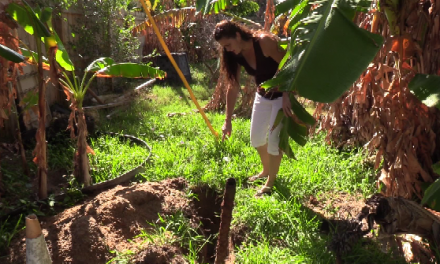“It’s just such a healthy, therapeutic thing to teach about the living soil.”
Flint gardens with his own children and has helped hundreds of other children become involved in school and community gardening. At first, he says, they just play in the garden, “grazing” on vegetables. Incorporate planting and play, and kids become more comfortable. We can teach even the tiniest child garden etiquette, such as where to walk. Later, they learn the consequences of good (or poor) care: watering, weeding, cultivating.
Moreover, both kids and adults learn patience in the garden. We have to wait for nature to take its course. “Keep kids’ gardens simple,” Flint advises, “and a manageable size, about 6 by 10 feet.” Begin with only a few seed or plant varieties that grow quickly, and give the children tasks appropriate to their age and skill level. Watering is a favorite and even weeding can be. The pathway to better health and nutrition is right outside the door. Of course gardening offers great opportunities for exercise, fresh air, and good food. “Growing their own food expands a young person’s choice of foods, a key to good nutrition,” Flint notes. “If they have grown up on home-grown and homemade food, they can taste the difference.” Most Americans live in cities and are removed from their food sources. Will Allen, director of Growing Power, a nationally recognized nonprofit organization that promotes urban agriculture, believes we need to reconnect our youth with the land-right now. For him, it all comes down to the soil. “It’s just such a healthy, therapeutic thing to teach about the living soil. Kids can be wired, and they calm down when they work in the soil. To eat something you produce is a worthwhile and meaningful thing.”
Though success is relative in the world of gardening, positive experiences do help sustain interest for kids. One child learns that worms are not just slimy and gross; they are garden friends. Another masters the art of measuring his growing corn stalk. A third extends garden learning at the computer. A fourth pulls a carrot from the earth, brushes it off, and eats it. All have had successful experiences. You can guide a child to have his or her own successful gardening experience, but you must explore yourself. You and they must learn from your mistakes. Celebrate wonder. The key to success and sustained interest lies within you and the little gardener(s) with whom you plant the seeds of hope—which is, of course, what a seed is and what a garden is—a promise of what will come.
Top Tips For Novice Gardeners
1. Choose a site with as much sun as possible! If there is no sunny space, you can still plant a garden. Simply choose plants that thrive in shade.
2. Have your soil tested so you know its acidity or alkalinity. (Contact your local extension office.) Treat your soil and garden organically. Don’t use chemical pesticides or fertilizers.
3. Do not plan too large a garden. It is far better to begin with a small plot and increase the garden’s size when the gardener is ready.
4. Dig the earth in your chosen garden site to loosen the soil. Add somecompost to enrich it. Rake it smooth.
5. Keep the garden plan simple. Allow plenty of space for paths (at least 24 inches) and easy access to each plant (no more than a 24-inch stretch).
6. Choose only a few varieties of plants to begin. Add others as you and your young gardener learn how much space and how much attention your garden requires.
7. Choose plants and seeds that are appropriate for your site- sun-loving plants for sunny areas, shade-loving plants for shade. Ask before you buy plants; read the instructions on the seed packet before purchasing.
8. Choose good-quality tools that fit your young gardener’s hands. Plastic “toy tools” are not adequate. Many garden tool manufacturers make child-size tools. Ask at your local garden center or check mail-order catalogs. Use tools properly. For safety’s sake, never leave a shovel, hoe, or rake with its “working side” up. When it’s not in use, stand or lean it securely against a vertical surface, such as a fence or building. Or lay it down, turning the blade/tines toward the ground.
9. As you and your companion(s) begin to plant, offer reasonable instruction, but do not be too particular. Seeds do not need to be planted in a straight row. Plant them in a circle or in a free-form design, or scatter them. Never cry over spilled seed.
10. Try not to walk in the garden right after it rains. It compresses the soil and makes it hard.
11. Wait until the soil is moist before you try weeding. Then pull each weed gently, from its base, to remove the whole root.
12. Another option for those with limited space is to plant in containers. A flowerbox or large flowerpot can brighten your deck, balcony, windowsill, stoop, or stairway. Choose seeds and plants appropriate for the size of the container. (See “Sprouts for Sprouts” below.)
13. Harvest the fruits and blossoms of your garden with wonder and love—and share them with family and friends.
Sprouts For Sprouts
These simple and fun-to-grow seed selections are favorites of young gardeners. Smaller varieties of all these seeds are terrific in containers as well as in the ground.
Flowers
Alyssum (Lobularia maritime) Great for creating a carpet in miniature gardens as well as for creating borders around a child’s plot. Carpet of Snow is classic and easy to grow.
Cosmos (Cosmos spp.) In shades of pink, lavender, and white, as well as in bright orange, cosmos is drought-tolerant, free-flowering, and self-seeding, giving color and grace to all kids’ gardens. Choose any variety, or get seeds from a neighbor.
Marigolds (Tagetes spp.) Marigolds, especially the tiny and mixed French varieties, are hardy and so fast-growing that children can plant seeds in pots for Mother’s Day presentations that are always a treat. Planted within a child’s garden, the marigold is a natural pesticide and a common companion plant to tomatoes.
Morning Glories (Ipomoea spp.) Nothing beats Heavenly Blue morning glories that grace a trellis, a fence, an arbor, or a garden “house” with walls made of sunflowers. Morning glories also come in white, pink, and lavender.
Sunflowers (Heliantus annus) Sunflowers do best in full sun; because tall varieties can sometimes reach for the sun, they often flourish unexpectedly. The basis for a sunflower house, the tallest varieties are a delight, and strong enough to support the morning glories that entwine their stalks. Seek out the familiar golden petals surrounding a dark center, but don’t overlook the myriad varicolored varieties now available, as well as small varieties. Sunflowers are beautiful in the garden and attract birds and insects, as well as small rodents, when the seeds ripen. Simply a must for you and your child gardener.
Zinnias (Zinnia spp.) Zinnias germinate readily and produce bright spots in your garden and your hearts as children enjoy them growing and to cut for bouquets. Although the “giant” varieties are great, they may not be as delightful to children as Z. elegans, the popular Thumbelina, or some old fashioned mixes. Choose quick-maturing vegetables for spring salad gardens and for sustaining interest, while waiting for slower-maturing plants such as tomatoes, peppers, and pumpkins.
Vegetables
Choose quick-maturing vegetables for spring salad gardens and for sustaining interest, while waiting for slower-maturing plants such astomatoes, peppers, and pumpkins.
Bush Beans Bush beans are quite easy and trouble-free, maturing earlier than pole varieties. Choose from many varieties, including brightly colored ones. The purple or burgundy variety is vibrant-colored outside and green inside, but the exterior turns green with cooking. Magic! Most delicious when picked young.
Pole Beans Choose these for the bean pole tepee. Pole beans are great space savers and continuous producers when picked often. Blue Lake and Kentucky Wonder are classic varieties.
Runner Beans Easy to grow, these vines make great fence covers. Scarlet runner beans are beautiful in bloom and extravagant in the pod, producing delightful seeds of many colors. (Jim Flint of Burlington Gardens recommends them for bean pole tepees.)
Beets Select either red or golden early varieties, Early Wonder or Golden. Tops and very early pickings are edible raw in salads or sauté as greens. Carrots (Daucus carota). For early eating, choose Thumbelina, a bite-sized shorty carrot, perfect for containers or heavy soils and for anxious eaters.
Corn Not everyone can grow corn in the space they have available, but when it is possible, corn is a staple of the Native American Three Sisters Garden, in which corn, beans, and squash are interplanted. Once again, choose smaller-eared, early varieties. Check out corn selections from localseed producers, when possible. Popcorn is easy to grow, but like ornamental corn, it requires a longer growing season.
Greens Greens are the staple of many diets, African American, European, and Asian among them. From mustards and collards to dandelion and purslane, greens in many varieties belong in all gardens. They are beautiful and good for you. And kids love them fresh from the garden.
Lettuce Loose-leaf varieties mature in about three to four weeks. Many varieties are sold in mixed packages called salad blends or mesclun mixes. They are perfect for kids’ gardens, including containers. Also look for New Red Fire or Little Gem.
Onions + Scallions Sown as sets (tiny onions) or seeds, these bursts of flavor are easy for children to recognize, and even the tops, chopped into salads, are a taste treat.
Peas Snap and snow peas are fast-growing cool-season plants that are sweet treats right from the vine, and although they require about two months, they are interesting to watch grow.
Peppers Sweet or hot, peppers, like beans, are staples in most diets, grown for pizza or salsa gardens. Little gardeners enjoy watching the fruits develop and change color. Banana and Jingle Bell (a miniature) mature earlier than traditional bell varieties. Hot peppers are delicious, but children need to learn how to handle them, because of the capsicum tendency to “burn.” Jalapeños are most familiar and fastest-ripening of most hot peppers.
Pumpkins Tiny pumpkins are a treat for kids of all ages. And they are not only cute but edible. Try Baby Boo or Jack Be Little varieties. When it comes to growing a jack-o-lantern-to-be, the “giant” varieties, if space allows, are terrific. Any size pumpkin, however, whether destined to become a pie or a magic lantern, is a great addition to a child’s garden.
Radishes These tiny cool-weather jewels are best grown in early spring or late summer. They are sweetest when harvested young. Their fast-maturing habit makes them perfect for children who delight in pulling the perfect fruit from the earth. Try Cherry Belle, Easter Egg, or short icicle varieties.
Spinach Another cool-weather plant, grown early, it ripens shortly after leaf lettuce. Try the bolt-resistant varieties and enjoy fresh in salads or sauté with breakfast, lunch, and dinner.
Swiss Chard Actually a member of the beet family, Swiss chard provides dark green veggies between spinach harvests. Try the multicolored Bright Lights, which is beautiful to grow and delicious to eat, making it a favorite of kids. It’s also good in containers.
Tomatoes Nothing beats the taste of the first ripe tomato grown in your own garden! For kids, the tine cherry, grape, and plum tomatoes are the most fun to grow, to eat, and to share. Early Cherry, Sweetie, and Golden Nugget (all cherry); Yellow Pear, Jolly Elf, and Morning Light (both grape) are terrific choices.
Tomatillos Salsa isn’t salsa without tomatillos. These plants are delightful to grow and interesting to children as well as adults. They resembletomatoes when growing.
Zucchini Zucchini and other summer squash are fun to grow, if your garden has space, because they grow so quickly. Squash is susceptible to numerous viruses and blights, however, and may not be ideal in some climates.
Fruits
Strawberries (June-bearing and everbearing varieties) If your child can grow only one fruit in your garden, make it strawberries. June bearers produce one large crop over two to three weeks early in summer. Everbearers produce smaller amounts throughout summer and fall. They’re a great treat for children grown in containers or in the ground. Plants produce runners, which can be used to grow even more plants.
Herbs
Chives This herb has a mild onion flavor and is easy to grow, indoors and outdoors. Kids like the tiny leaves and pretty blossoms.
Cilantro Cilantro and coriander are the same plant: Cilantro is the leaf form; coriander is the seed. Cilantro is a staple for salsa. It’s quick-growing, but be careful to cut it quickly, or it will bolt. Repeated plantings work well.
Epazote This traditional Mexican herb is added to bean dishes to prevent gas.
Oregano A perennial, oregano makes a great addition to a pizza garden.
Spearmint This hardy and prolific mint is great for teas, salads, and baking. A perennial, it grows well in containers.
Sweet Basil Even the very first leaves of this fast-growing herb contain flavor and fragrance. These simple and fun-to-grow seed selections are favorites of young gardeners. Smaller varieties of all these seeds are terrific in containers as well as in the ground.
*Article originally appeared at Rodale’s Organic Life












